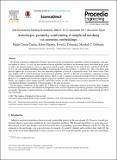| dc.contributor.author | Caplan, Philip Claude | |
| dc.contributor.author | Haimes, Robert | |
| dc.contributor.author | Darmofal, David L | |
| dc.contributor.author | Galbraith, Marshall C. | |
| dc.date.accessioned | 2018-05-07T19:56:13Z | |
| dc.date.available | 2018-05-07T19:56:13Z | |
| dc.date.issued | 2017-10 | |
| dc.identifier.issn | 1877-7058 | |
| dc.identifier.uri | http://hdl.handle.net/1721.1/115254 | |
| dc.description.abstract | We develop a dimension-independent, Delaunay-based anisotropic mesh generation algorithm suitable for integration with adaptive numerical solvers. As such, the mesh produced by our algorithm conforms to an anisotropic metric prescribed by the solver as well as the domain geometry, given as a piecewise smooth complex. Motivated by the work of Lévy and Dassi [10-12,20], we use a discrete manifold embedding algorithm to transform the anisotropic problem to a uniform one. This work differs from previous approaches in several ways. First, the embedding algorithm is driven by a Riemannian metric field instead of the Gauss map, lending itself to general anisotropic mesh generation problems. Second we describe our method for computing restricted Voronoi diagrams in a dimension-independent manner which is used to compute constrained centroidal Voronoi tessellations. In particular, we compute restricted Voronoi simplices using exact arithmetic and use data structures based on convex polytope theory. Finally, since adaptive solvers require geometry-conforming meshes, we offer a Steiner vertex insertion algorithm for ensuring the extracted dual Delaunay triangulation is homeomorphic to the input geometries. The two major contributions of this paper are: a method for isometrically embedding arbitrary mesh-metric pairs in higher dimensional Euclidean spaces and a dimension-independent vertex insertion algorithm for producing geometry-conforming Delaunay meshes. The former is demonstrated on a two-dimensional anisotropic problem whereas the latter is demonstrated on both 3d and 4d problems. Keywords: Anisotropic mesh generation; metric; Nash embedding theorem; isometric; geometry-conforming; restricted Voronoi diagram; constrained centroidal Voronoi tessellation; Steiner vertices; dimension-independent | en_US |
| dc.publisher | Elsevier BV | en_US |
| dc.relation.isversionof | http://dx.doi.org/10.1016/J.PROENG.2017.09.798 | en_US |
| dc.rights | Creative Commons Attribution-NonCommercial-NoDerivs License | en_US |
| dc.rights.uri | http://creativecommons.org/licenses/by-nc-nd/4.0/ | en_US |
| dc.source | Elsevier | en_US |
| dc.title | Anisotropic geometry-conforming d-simplicial meshing via isometric embeddings | en_US |
| dc.type | Article | en_US |
| dc.identifier.citation | Caplan, Philip Claude, et al. “Anisotropic Geometry-Conforming d-Simplicial Meshing via Isometric Embeddings.” Procedia Engineering, vol. 203, 2017, pp. 141–53. © 2017 The Authors | en_US |
| dc.contributor.department | Massachusetts Institute of Technology. Department of Aeronautics and Astronautics | en_US |
| dc.contributor.mitauthor | Caplan, Philip Claude | |
| dc.contributor.mitauthor | Haimes, Robert | |
| dc.contributor.mitauthor | Darmofal, David L | |
| dc.contributor.mitauthor | Galbraith, Marshall C. | |
| dc.relation.journal | Procedia Engineering | en_US |
| dc.eprint.version | Final published version | en_US |
| dc.type.uri | http://purl.org/eprint/type/JournalArticle | en_US |
| eprint.status | http://purl.org/eprint/status/PeerReviewed | en_US |
| dc.date.updated | 2018-03-19T14:34:09Z | |
| dspace.orderedauthors | Caplan, Philip Claude; Haimes, Robert; Darmofal, David L.; Galbraith, Marshall C. | en_US |
| dspace.embargo.terms | N | en_US |
| dc.identifier.orcid | https://orcid.org/0000-0001-5652-9913 | |
| mit.license | PUBLISHER_CC | en_US |
